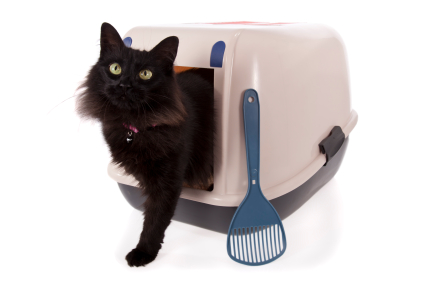Have you ever walked into a pet/grocery store and found yourself standing in the cat litter section with a look of total bewilderment?
Cat litter comes in various forms, materials, and scents! So the questions you begin to ask yourself…Clumping? Non -clumping? Scoopable? Non-scoopable? Scented? Unscented? Deodorizing? Non-deodorizing? Crystals? Sand? Clay? Biodegradable? Your head begins to spin – you begin to panic – you begin to sweat and think “Oh my Gosh! Making the decision on when to start expanding my human family was easier than this!”
This basically comes down to what Fluffy prefers. If Fluffy isn’t happy nobody is happy! So you grab whichever bag appeals more to you, take it home, fill the box and cross your fingers that Fluffy approves! Most times Fluffy will approve, however, the occasional feline will test your patience beyond belief. Some seem to be incredibly fussy!
No one particular litter is better than the next. However, here are some very important things to keep in mind:
Most cats DO NOT like strong, perfumed scents. They prefer the “au naturel” scent. They can also trigger allergic reactions and respiratory conditions such as Asthma. “Dusty” cat litters can create or exasperate pre-existing respiratory conditions.
Biodegradable is made from pine, paper, wheat or corn, therefore, are less toxic to the environment. Many are flushable. Tend to be generally healthier for humans and cats with respiratory conditions. Clumping and non-clumping
Clay Based Clumping absorbs liquid waste and forms clumps that are easily removed. Excellent odor control if waste is removed regularly. Simply top up the box as needed. Completely replace all litter monthly.
Clay Based Non Clumping absorbs liquid waste but does not clump. Odor control varies. These must be replaced more often than clumping (min weekly)
Crystalis made from sand or sand blends. Absorbable but does not form easily removable clumps. Good odor control if replaced regularly.
Next comes the choosing of the “litter accommodations” The box you choose is thankfully an easier decision.
Important things to remember:
1) make sure there is AMPLE room for the cat to move around comfortably. A larger cat will require a larger box. Keep in mind the level of litter used and whether or not it’s a covered box will affect square footage
2) Ensure there is an adequate amount of litter in it. Level needs to be quite deep in order for clumping action to work well and
3) the best rule of thumb to always follow is to provide 1 litter box PLUS 1 for every cat in the home (ie: 2 cats = 3 boxes) As for covered or not, that comes down to what your cat prefers. Some cats prefer to be more *hidden* when doing their business. Others prefer to be able to *keep watch* around them. A covered box traps dust and odors more easily, therefore, requires more dedication to scooping/cleaning.
LOCATION LOCATION LOCATION! Where you place the litter box can also greatly impact whether this whole ordeal is a success or fail. If you’re thinking about putting the box in the furthest most hidden location of your home, you might want to think again. If your cat has to walk a mile to use the box s/he may just decide that the carpet in the corner of the living room is much closer and requires a lot less effort. Hey, when you have to go you have to go now! Multiple boxes placed in various strategic locations will help ensure success, therefore, making both you and Fluffy happy!



